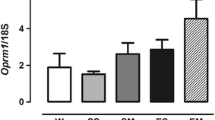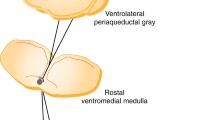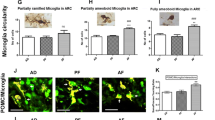Abstract
The periaqueductal gray (PAG) has been reported as a potential site for opioid regulation of behavioral selection. Opioid-mediated behavioral and physiological responses differ between nulliparous and multiparous females. This study addresses the effects of multiple reproductive experiences on μ-, κ- and δ-opioid receptor (Oprm1, Oprk1, and Oprd1 respectively) gene activity and μ, κ and δ protein expression (MOR, KOR and DOR respectively) in the PAG of the female rats. This was done by evaluating the opioid gene expression using real-time (RT-PCR) and quantification of each protein receptor by Western blot analysis. The RT-PCR results show that multiple reproductive experiences increase Oprm1 and Oprk1 gene expression. Western blot analysis revealed increased MOR and KOR while DOR protein was decreased in multiparous animals. Taken together, these data suggest that multiple reproductive experiences influence both gene activity and opioid receptor expression in the PAG. Post-translational mechanisms seem particularly relevant for DOR expression. Thus, opioid transmission in the PAG might be modulated by different mechanisms of multiparity-induced plasticity according to the opioid receptor type.


Similar content being viewed by others
References
Bandler R, Shipley MT (1994) Columnar organization in the midbrain periaqueductal gray—modules for emotional expression. Trends Neurosci 17:379–389
Bridges RS, Hammer RP Jr (1992) Parity-associated alterations of medial preoptic opiate receptors in female rats. Brain Res 578:269–274
Bridges RS, Felicio LF, Pellerin LJ, Stuer AM, Mann PE (1993) Prior parity reduces post-coital diurnal and nocturnal prolactin surges in rats. Life Sci 53:439–445
Byrnes EM (2008) Chronic morphine exposure during puberty induces long-lasting changes in opioid-related mRNA expression in the mediobasal hypothalamus. Brain Res 1190:186–192
Byrnes EM, Bridges RS (2000) Endogenous opioid facilitation of maternal memory in rats. Behav Neurosci 114:797–804
Cameron AA, Khan IA, Westlund KN, Cliffer KD, Willis WD (1995a) The efferent projections of the periaqueductal gray in rat: a Phaseolus vulgaris-leucoagglutinin study I. Ascending projections. J Comp Neurol 351:568–584
Cameron AA, Khan IA, Westlund KN, Willis WD (1995b) The efferent projections of the periaqueductal gray in rat: a Phaseolus vulgaris-leucoagglutinin study. II. Descending projections. J Comp Neurol 351:585–601
Dahl JL, Silva BW, Baker TB, Tiffany ST (1986) Endogenous analgesia in the pregnant rat: an artifact of weight-dependent measures? Brain Res 373:316–323
Felicio LF, Florio JC, Sider LH, Cruz-Casallas PE, Bridges RS (1996) Reproductive experience increases striatal and hypothalamic dopamine levels in pregnant rats. Brain Res Bull 40:253–256
Floyd NS, Price JL, Ferry AT, Keay KA, Bandler R (2000) Orbitomedial prefrontal cortical projections to distinct longitudinal columns of the periaqueductal gray in the rat. J Comp Neurol 422:556–578
Gintzler AR (1980) Endorphin-mediated increases in pain threshold during pregnancy. Science 210:193–195, 4466
Hammer RP Jr, Mateo AR, Bridges RS (1992) Hormonal regulation of medial preoptic mu-opiate receptor density before and after parturition. Neuroendocrinology 56:38–45
Jürgens U (1994) The role of the periaqueductal grey in vocal behavior. Behav Brain Res 62:107–117
Kaey KA, Bandler R (2001) Parallel circuits mediating distinct emotional coping reactions to different types of stress. Neurosci Biobehav Rev 25:669–678
Kinsley CH, Bridges RS (1988) Parity-associated reductions in behavioral sensitivity to opiates. Biol Reprod 39:270–278
Kinsley CH, Bardi M, Karelina E, Rima B, Christon L, Friedenberg J et al (2006) Track, attack, consume: pregnancy/parenthood induction of an improved predatory behavioral repertoire and accompanying neural enhancements in the rat, Program No. 573.20/LL98. 2006 Neuroscience Meeting. Society for Neuroscience, Atlanta, GA
Livak KJ, Schmittgen TD (2001) Analysis of relative gene expression data using real-time quantitative PCR and the 2(-Delta Delta C(T)) Method. Methods 25:402–408
Lonstein JS, Stern JM (1998) Site and behavioral specificity of periaqueductal gray lesions on postpartum sexual, maternal, and aggressive behaviors in rats. Brain Res 804:21–35
Mann PE, Pasternak GW, Bridges RS (1990) Mu1 opioid receptor involvement in maternal-behavior. Physiology and Behavior 47:133–138
Mansour A, Watson SJ, Akil H (1995) Opioid receptors: past, present and future. Trends Neurosci 18:69–70
Miranda-Paiva CM, Nasello AG, Yim AJ, Felicio LF (2002) Puerperal blockade of cholecystokinin (CCK1) receptors disrupts maternal behavior in lactating rats. J Mol Neurosci 18:97–104
Miranda-Paiva CM, Ribeiro-Barbosa ER, Canteras NS, Felicio LF (2003) A role for the periaqueductal grey in opioidergic inhibition of maternal behaviour. Eur J Neurosci 18:667–674
Miranda-Paiva CM, Canteras NS, Sukikara MH, Nasello AG, Mackowiak II, Felicio LF (2007) Peptides 28:657–662
Mota-Ortiz SR, Sukikara MH, Felicio LF, Canteras NS (2009) Afferent connections to the rostrolateral part of the periaqueductal gray: a critical region influencing the motivation drive to hunt and forage. Neural Plast 2009:612698
Sakuma Y, Pfaff DW (1979) Facilitation of female reproductive behavior from mesensephalic central gray in the rat. Am J Physiol 237:R278–R284
Sukikara MH, Mota-Ortiz SR, Baldo MV, Felicio LF, Canteras NS (2006) A role for the periaqueductal gray in switching adaptive behavioral responses. J Neurosci 26:2583–2589
Sukikara MH, Mota-Ortiz SR, Baldo MV, Felicio LF, Canteras NS (2010) The periaqueductal gray and its potential role in maternal behavior inhibition in response to predatory threats. Behav Brain Res 209:226–233
Teodorov E, Modena CC, Sukikara MH, Felicio LF (2006) Preliminary study of the effects of morphine treatment on opioid receptor gene expression in brain structures of the female rat. Neuroscience 141:1225–1231
Wartella J, Amory E, Lomas LM, Macbeth A, McNamara I, Stevens L, Lambert KG, Kinsley CH (2003) Single or multiple reproductive experiences attenuate neurobehavioral stress and fear responses in the female rat. Physiol Behav 79:373–381
Author information
Authors and Affiliations
Corresponding author
Rights and permissions
About this article
Cite this article
Teodorov, E., Bernardi, M.M., Ferrari, M.F.R. et al. Plasticity of Opioid Receptors in the Female Periaqueductal Gray: Multiparity-Induced Increase in the Activity of Genes Encoding for Mu and Kappa Receptors and a Post-Translational Decrease in Delta Receptor Expression. J Mol Neurosci 43, 175–181 (2011). https://doi.org/10.1007/s12031-010-9407-0
Received:
Accepted:
Published:
Issue Date:
DOI: https://doi.org/10.1007/s12031-010-9407-0




